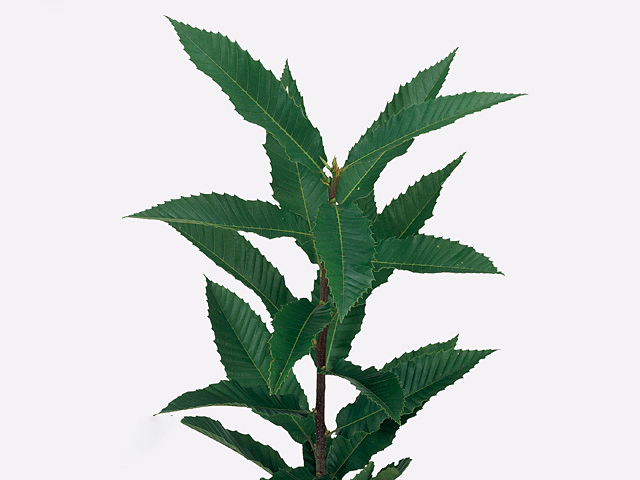Castanea sativa

| Life span | Long (over 200 years) |
| Shape of tree | Elliptic |
| Fruit type | Capsule |
| Leaf type | Foliage leaf |
| Winter hardness | Good (USDA-zone 5, 6) |
| Soil fertility | No poor soils |
| Inflorescence | Catkin |
| Leaf duration | Deciduous |
| Light conditions | Sunny; Semi-shades |
| Growth rate | Normal; Fast |
| Leaf division | Simple |
| Plant, growth type | Erect |
| Flower sex (distribution) | Monoecious (flowers unisexual) |
| Sensibilité au sel d'épandage | Sensitive |
| Fruit-bearing period (notable) | Autumn (October/November) |
| Fruit color (notable) | Green |
| Autumn color (notable) | Yellow |
| Toxicity (if consumed) | Not or barely |
| Moisture requirements | Wet; Moist |
Castanea sativa, commonly known as the chestnut tree, is a long-lived tree species with a life span of over 200 years. Its distinctive elliptic shape and foliage leaves make it a visually appealing addition to any landscape.
One of the notable characteristics of the chestnut tree is its fruit, which comes in the form of a capsule. These chestnuts are typically harvested in autumn, during the months of October and November. The fruit itself is green in color, and the tree's autumn coloration gives way to beautiful yellow hues.
Chestnut trees have a deciduous leaf type, meaning that they shed their leaves during the winter months. However, they possess a good winter hardness and can thrive in USDA zones 5 and 6, which experience colder temperatures.
In terms of light requirements, chestnut trees prefer sunny or semi-shaded conditions. They can tolerate a wide range of soil fertility but do not thrive in poor soils. The tree's growth rate is considered normal to fast, making it a relatively quick addition to any landscape.
The leaves of the chestnut tree are simple, meaning they are not divided into smaller leaflets. The plant grows erectly, adding a vertical element to its overall shape. The inflorescence of the tree appears in the form of catkins and the flowers are monoecious, meaning the tree produces both male and female flowers.
While the chestnut tree is generally not consumed by animals or humans, it is worth noting that it has low toxicity levels if consumed in small amounts. However, it is always advisable to exercise caution and seek medical advice if there is any concern regarding the consumption of parts of this tree.
When it comes to moisture requirements, chestnut trees prefer wet to moist conditions. Adequate watering and proper drainage should be provided to maintain optimal health and growth.
Overall, the Castanea sativa, or chestnut tree, is a stunning and versatile tree species that can enhance any landscape. With its long life span, beautiful foliage, and productive fruit-bearing capabilities, it is a valuable addition to gardens, parks, and forests alike.
Market availability index by month:
| Jan. | Feb. | Mar. | Apr. | May | Jun. | Jul. | Aug. | Sep. | Oct. | Nov. | Dec. |
|---|---|---|---|---|---|---|---|---|---|---|---|
| 3 | 3 | 3 | 3 | 4 | 3 | 3 | 3 | 3 | 4 | 4 | 4 |